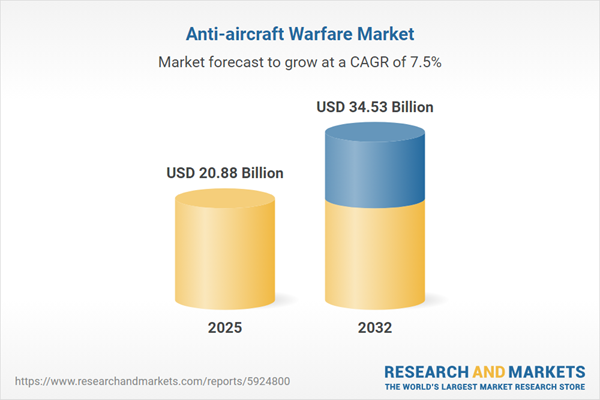Speak directly to the analyst to clarify any post sales queries you may have.
The anti-aircraft warfare market is defined by constant adaptation, as evolving global threats and technological innovation reshape defense priorities and operational requirements. Senior decision-makers must navigate this complex environment to secure future-ready air defense capabilities.
Market Snapshot: Anti-Aircraft Warfare Market Growth and Outlook
Between 2024 and 2032, the anti-aircraft warfare market is projected for robust, consistent expansion, with significant investments flowing from defense agencies worldwide. Rising demand is grounded in the ongoing modernization of essential assets, as militaries seek to elevate next-generation air defense systems to respond effectively within challenging operational theaters. Interoperability improvements are accelerating collaborative projects and promoting agile adaptations to new threats. In this context, anti-aircraft warfare remains central to defense planning, shaping national security agendas and serving as a foundation for broader military priorities.
Scope & Segmentation of the Anti-Aircraft Warfare Market
This comprehensive report offers actionable insights enabling decision-makers to optimize operational efficiency and sharpen strategic foresight in active defense landscapes. The segment analysis details how emerging technologies, strategic integration, and adaptive procurement patterns influence deployment and long-term readiness.
- Product Types: Directed energy systems such as lasers and microwave technologies offer non-kinetic engagement. Electronic warfare countermeasures bolster defensive capacity, while gun-based systems provide deployable response options. Missile platforms support multi-domain engagement across various airspace scenarios.
- Engagement Ranges: Solutions encompass very short, short, medium, and long-range defense tiers, facilitating customized airspace protection and rapid threat interception in diverse operational environments.
- Guidance Types: Technologies include command and control, infrared, radar, and optical guidance, strengthening threat detection and adaptive targeting even in dynamic or congested airspace.
- Platform Types: Integration across land, naval, and airborne assets enables layered defense strategies, encouraging flexibility and cross-domain force synergy.
- System Components: Key infrastructure elements comprise command and control centers, launch units, networked sensors, and real-time data platforms, forming the backbone of day-to-day operations in integrated air defense systems.
- End Users: Stakeholders include air forces, navies, armies, and specialized defense agencies, each deploying customized solutions to address unique mission profiles and defense postures.
- Applications: Market coverage spans aircraft protection, interception of emerging threats such as missiles and UAVs, and application of precision countermeasures to mitigate airborne risks.
- Regional Coverage: Analysis highlights the Americas, Europe, Middle East and Africa, and Asia-Pacific, addressing differences in defense priorities, regional threat outlooks, and regulatory environments that influence procurement and deployment.
- Leading Companies: The competitive landscape features major organizations including Lockheed Martin, Raytheon, Northrop Grumman, BAE Systems, Thales, Leonardo, MBDA, Rafael Advanced Defense Systems, Airbus, and Saab, whose innovations continually shape overall market direction.
Key Takeaways for Decision-Makers
- Increased adoption of autonomous and digitally networked platforms improves real-time situational awareness and enables faster operational responses across multiple defense domains.
- Procurement strategies are emphasizing collaboration with local suppliers, strengthening project agility and long-term supply chain resilience amid evolving supplier ecosystems.
- Development of multi-domain, integrated defense architectures supports versatile asset deployment, ensuring rapid adaptation to emerging airspace threats and sustained mission readiness.
- International alliances and modernization initiatives offer defense organizations the flexibility to direct resources toward swiftly developing capability gaps and evolving priorities.
- Collaboration between system developers and manufacturers accelerates technology integration, equipping organizations to adapt to strategic changes and maintain operational relevance.
- Digital engineering practices and modular product designs streamline upgrade cycles, enhance maintainability, and support continuous attainment of mission objectives.
Tariff Impact and Supply Chain Readiness
Recent shifts in U.S. tariffs mean defense supply chains are focusing on regional sourcing and closer ties to local suppliers. This transition increases supply chain stability and ensures consistent delivery, even during broad global disruptions, supporting sustained risk mitigation for critical defense contracts.
Methodology & Data Sources
Findings are built from interviews with senior executives, direct feedback from procurement professionals, and a detailed review of current technical and regulatory sources. This triangulation ensures reliable, actionable market intelligence for strategic decision-making.
Why This Report Matters for Defense Leadership
- Enables leaders to align procurement and resource planning with developing military and security needs, improving risk management.
- Clarifies current technology trends and operational best practices, promoting agile modernization and stable supply chains.
- Delivers targeted recommendations to address air defense complexity, strengthening organizational readiness across all operational levels.
Conclusion
This report equips senior defense leaders with strategic insights to enhance procurement, planning, and capability deployment. Leverage these findings to foster operational preparedness and maintain a decisive advantage in the anti-aircraft warfare market.
Additional Product Information:
- Purchase of this report includes 1 year online access with quarterly updates.
- This report can be updated on request. Please contact our Customer Experience team using the Ask a Question widget on our website.
Table of Contents
3. Executive Summary
4. Market Overview
7. Cumulative Impact of Artificial Intelligence 2025
Companies Mentioned
The companies profiled in this Anti-aircraft Warfare market report include:- Lockheed Martin Corporation
- Raytheon Technologies Corporation
- Northrop Grumman Corporation
- BAE Systems plc
- Thales S.A.
- Leonardo S.p.A.
- MBDA SA
- Rafael Advanced Defense Systems Ltd.
- Airbus SE
- Saab AB
Table Information
| Report Attribute | Details |
|---|---|
| No. of Pages | 187 |
| Published | October 2025 |
| Forecast Period | 2025 - 2032 |
| Estimated Market Value ( USD | $ 20.88 Billion |
| Forecasted Market Value ( USD | $ 34.53 Billion |
| Compound Annual Growth Rate | 7.4% |
| Regions Covered | Global |
| No. of Companies Mentioned | 11 |









